Design and Optimization Strategy of a Net-Zero City Based on a Small Modular Reactor and Renewable Energy
Abstract
1. Introduction
2. SSNC Microgrid Design for Net-Zero City
2.1. Energy Block Modeling of Net-Zero City
2.2. SSNC Operation Platform of Net-Zero City
2.3. SSNC Dynamic Modeling
2.3.1. Consumer Load Modeling
Residential Load Modeling
- ;
- ;
- ;
- .
- ;
- .
Commercial and Industrial (C&I) Load
- ;
- .
2.3.2. Sector Coupling Demand Modeling
Hydrogen Production Through Electrolysis
- ;
- ;
- ;
- .
Heat Generation Through Heat Pumps
- ;
- ;
- .
2.3.3. Solar Power Generation Modeling
- ;
- ;
- ;
- .
2.3.4. SMR Power Generation Modeling
- ;
- ;
- .
2.3.5. Governing Equation of SSNC
3. SSNC Microgrid Framework for Development and Demonstration
3.1. Pattern Generation from Dynamic Characteristics
3.2. State Variables: Consumer Demand and Solar Power Generation
3.3. Control Variables: SMR Generation and Sector Coupling Demand (Hydrogen Production)
4. SSNC Testbed and Optimal Control Algorithm
4.1. Overview of SSNC Testbed
4.2. Operation of the State-Variable-Based SSNC Testbed
4.3. SSNC Optimal Control Algorithm
- ;
- .
- = SMR generation at time (MW)
- .
- (maximum change rate ± 50 MW/h);
- (maximum change rate ± 50 MW/h);
- ESS charging/discharging rate (MW)
- State of Charge at (MWh)
- Optimal Control: minimize objective function;
- Robust Control: maintain where
4.4. Results of the Optimal Control Algorithm
5. Conclusions
Author Contributions
Funding
Data Availability Statement
Conflicts of Interest
References
- World Economic Forum and Accenture. Net-Zero Industry Tracker; World Economic Forum: Geneva, Switzerland, 2023. [Google Scholar]
- United Nations Environment Programme (UNEP). Cities and Climate Change. (IPCC, 2022). Available online: https://www.unep.org/explore-topics/resource-efficiency/what-we-do/cities-and-climate-change (accessed on 10 April 2025).
- International Energy Agency (IEA). Empowering Urban Energy Transitions. (IEA Report 2024). Available online: https://www.iea.org/reports/empowering-urban-energy-transitions (accessed on 11 April 2025).
- World Bank. Cities Key to Solving Climate Crisis. 2023. Available online: https://www.worldbank.org/en/news/press-release/2023/05/18/cities-key-to-solving-climate-crisis (accessed on 11 April 2025).
- United Nations Framework Convention on Climate Change (UNFCCC). Urban Climate Action Is Crucial to Bend the Emissions Curve. 2020. Available online: https://unfccc.int/news/urban-climate-action-is-crucial-to-bend-the-emissions-curve (accessed on 11 April 2025).
- United Nations Human Settlements Programme (UN-Habitat). Climate Change. 2023. Available online: https://unhabitat.org/topic/climate-change (accessed on 11 April 2025).
- Luqman, M.; Rayner, P.J.; Gurney, K.R. On the impact of urbanisation on CO2 emissions. npj Urban Sustain. 2023, 3, 6. [Google Scholar] [CrossRef]
- IEA. Renewables 2020—Analysis and forecast to 2025; International Energy Agency: Paris, France, 2020. [Google Scholar]
- MIT Technology Review. Toronto Wants to Kill the Smart City Forever; MIT Technology Review: Utrecht, The Netherlands, 2022. [Google Scholar]
- Emerging Tech Brew. What Cities Can Learn from Sidewalk and Toronto’s Failed Smart City Project; Emerging Tech Brew: Data City, TX, USA, 2022. [Google Scholar]
- Sidewalk Labs. Toronto Project Final Report; Sidewalk Labs: Toronto, ON, Canada, 2020. [Google Scholar]
- Rezk, H.; Kanagaraj, N.; Al-Dhaifallah, M. Design and Sensitivity Analysis of Hybrid Photovoltaic-Fuel-Cell-Battery System to Supply a Small Community at Saudi NEOM City. Sustainability 2020, 12, 3341. [Google Scholar] [CrossRef]
- The Wall Street Journal. What Went Wrong at Saudi Arabia’s Futuristic Metropolis in the Desert; The Wall Street Journal: New York, NY, USA, 2025. [Google Scholar]
- NEOM. Project Overview; NEOM: Neom, Saudi Arabia, 2021; Available online: https://www.neom.com/en-us/about (accessed on 11 April 2025).
- Soshinskaya, M.; Crijns-Graus, W.H.J.; Guerrero, J.M.; Vasquez, J.C. Microgrids: Experiences, Barriers and Success Factors. Renew. Sustain. Energy Rev. 2014, 40, 659–672. [Google Scholar] [CrossRef]
- Moreno Escobar, J.J.; Morales Matamoros, O.; Tejeida Padilla, R.; Lina Reyes, I.; Quintana Espinosa, H. A Comprehensive Review on Smart Grids: Challenges and Opportunities. Sensors 2021, 21, 6978. [Google Scholar] [CrossRef] [PubMed]
- Akinyele, D.O.; Belikov, J.; Levron, Y. Challenges of Microgrids in Remote Communities: A STEEP Model Application. Energies 2018, 11, 432. [Google Scholar] [CrossRef]
- Marnay, C.; Asano, H.; Papathanassiou, S.; Strbac, G. Policymaking for Microgrids. IEEE Power Energy Mag. 2008, 6, 66–77. [Google Scholar] [CrossRef]
- Hirsch, A.; Parag, Y.; Guerrero, J. Microgrids: A Review of Technologies, Key Drivers, and Outstanding Issues. Renew. Sustain. Energy Rev. 2018, 90, 402–411. [Google Scholar] [CrossRef]
- Mengelkamp, E.; Gärttner, J.; Rock, K.; Kessler, S.; Orsini, L.; Weinhardt, C. Designing microgrid energy markets: A case study: The Brooklyn Microgrid. Appl. Energy 2018, 210, 394–405. [Google Scholar] [CrossRef]
- Lund, H.; Østergaard, P.A.; Connolly, D.; Mathiesen, B.V. Smart energy and smart energy systems. Energy 2017, 137, 556–565. [Google Scholar] [CrossRef]
- IRENA. Innovation Outlook: Renewable Mini-Grids; International Renewable Energy Agency: Abu Dhabi, United Arab Emirates, 2016. [Google Scholar]
- Hu, H.; Sun, F.; Guo, W.; Pan, L. Net-Zero Intelligent Energy System: Road to a Successful Carbon Neutral Future. In Proceedings of the 2022 12th International Conference on Power, Energy and Electrical Engineering (CPEEE), Shiga, Japan, 25–27 February 2022; pp. 285–291. [Google Scholar] [CrossRef]
- Yu, M.G.; Ma, X.; Huang, B.; Devaprasad, K.; Brown, F.; Wu, D. Enhancing Building Energy Efficiency through Advanced Sizing and Dispatch Methods for Energy Storage. arXiv 2023, arXiv:2310.13177. [Google Scholar] [CrossRef]
- Poudel, B.; Gokaraju, R. Small modular reactor (SMR) based hybrid energy system for electricity & district heating. IEEE Trans. Energy Convers. 2021, 36, 2794–2802. [Google Scholar] [CrossRef]
- Idaho National Laboratory (INL). Advanced Small Modular Reactors; INL Trending Topics: Idaho Falls, ID, USA, 2023. [Google Scholar]
- Soler, V.; Berthelemy, M.; Verma, A.; Bilbao y Leon, S.; Kwong, G.; Sozoniuk, V.; White, A.; Rouyer, V.; Sexton, K.; Vasquez-Maignan, X. Small Modular Reactors: Challenges and Opportunities; Report No. NEA-7560; Organization for Economic Co-Operation and Development (OECD), Nuclear Energy Agency (NEA): Paris, France, 2021. [Google Scholar]
- World Nuclear Association. Small Nuclear Power Reactors; World Nuclear Association Information Library: London, UK, 2023. [Google Scholar]
- Boudot, C.; Droin, J.B.; Sciora, P.; Besanger, Y.; Robisson, B.; Mazauric, A.L. Small Modular Reactor-Based Solutions to Enhance Grid Reliability: Impact of Modularization of Large Power Plants on Frequency Stability. EPJ Nuclear Sci. Technol. 2022, 8, 16. [Google Scholar] [CrossRef]
- Kang, S.W.; Yim, M.S. Coupled system model analysis for a small modular reactor cogeneration (combined heat and power) application. Energy 2023, 262, 125481. [Google Scholar] [CrossRef]
- Vinoya, C.L.; Ubando, A.T.; Culaba, A.B.; Chen, W.-H. State-of-the-Art Review of Small Modular Reactors. Energies 2023, 16, 3224. [Google Scholar] [CrossRef]
- Locatelli, G.; Boarin, S.; Pellegrino, F.; Ricotti, M.E. Load Following with Small Modular Reactors (SMR): A Real Options Analysis. Energy 2015, 80, 41–54. [Google Scholar] [CrossRef]
- Advanced Nuclear Pathways to Commercial Liftoff; Report Update Summary Presentation; U.S. Department of Energy: Washington, DC, USA, 2024.
- Small Modular Reactors: Advances in SMR Developments IAEA 2024. Available online: https://www.iaea.org/publications/15790/small-modular-reactors-advances-in-smr-developments-2024 (accessed on 11 April 2025).
- Larson, A. A Closer Look at Two Operational Small Modular Reactor Designs. World Nuclear Report, 1 March 2024. Available online: https://www.powermag.com/a-closer-look-at-two-operational-small-modular-reactor-designs/ (accessed on 11 April 2025).
- U.S. Department of Energy (DOE). Economic Impacts of Construction and Operation of a Small Modular Reactor on Tennessee; Baker Center Report; U.S. Department of Energy (DOE): Washington, DC, USA, 2024.
- Idaho National Laboratory. Small Reactors in Microgrids; Energy and Environment Science and Technology: Idaho Falls, ID, USA, 2023. [Google Scholar]
- Gabbar, H.A.; Esteves, O.L.A. Real-Time Simulation of a Small Modular Reactor in-the-Loop within Nuclear-Renewable Hybrid Energy Systems. Energies 2022, 15, 6588. [Google Scholar] [CrossRef]
- Idaho National Laboratory. MOOSE (Multiphysics Object Oriented Simulation Environment); Idaho National Laboratory: Idaho Falls, ID, USA, 2024. [Google Scholar]
- Abrishambaf, O.; Faria, P.; Gomes, L.; Spínola, J.; Vale, Z.; Corchado, J.M. Implementation of a Real-Time Microgrid Simulation Platform Based on Centralized and Distributed Management. Energies 2017, 10, 806. [Google Scholar] [CrossRef]
- Zhan, S.; Lei, Y.; Chong, A. Comparing Model Predictive Control and Reinforcement Learning for the Optimal Operation of Building-PV-Battery Systems. E3S Web Conf. 2023, 396, 04018. [Google Scholar] [CrossRef]
- Bordons, C.; Garcia-Torres, F.; Ridao, M.A. Model Predictive Control of Microgrids; Advances in Industrial Control; Springer: Cham, Switzerland, 2020. [Google Scholar] [CrossRef]
- Zhang, Y.; Zhang, T.; Wang, R.; Liu, Y.; Guo, B. Optimal Operation of a Smart Residential Microgrid Based on Model Predictive Control by Considering Uncertainties and Storage Impacts. Solar Energy 2015, 122, 1052–1065. [Google Scholar] [CrossRef]
- Mignacca, B.; Locatelli, G. Economics and Finance of Small Modular Reactors: A Systematic Review and Research Agenda. Renew. Sustain. Energy Rev. 2020, 118, 109519. [Google Scholar] [CrossRef]
- Korea Hydro & Nuclear Power. Korea Hydro & Nuclear Power Presents Innovative Nuclear Solutions for a Net-Zero Future at COP28; PR Newswire Asia: Dubai, United Arab Emirates, 2023. [Google Scholar]
- Korea Hydro & Nuclear Power. KHNP Unveils SMR Solutions in the US for Humanity’s Future; KHNP: Gyeongju, Republic of Korea, 2024. [Google Scholar]
- Korea Hydro & Nuclear Power. e-Brochure, i-SMR. 2023. Available online: https://www.khnp.co.kr/eng/selectBbsNttList.do?bbsNo=88&key=569#n (accessed on 11 April 2025).
- Korea Hydro & Nuclear Power. SSNC, SMR Smart Netzero City. 2023. Available online: http://ebook.khnp.co.kr/Viewer/6B1VIDHTNLDB (accessed on 11 April 2025).
- Rostami, Z.; Ravadanegh, S.N.; Kalantari, N.T.; Guerrero, J.M.; Vasquez, J.C. Dynamic Modeling of Multiple Microgrid Clusters Using Regional Demand Response Programs. Energies 2020, 13, 4050. [Google Scholar] [CrossRef]
- Gheorghe, G.; Neagu, B. Regression Analysis-Based Load Modelling for Electric Distribution Networks. In Numerical Methods for Energy Applications; Tabatabaei, N.M., Bizon, N., Eds.; Springer: Cham, Switzerland, 2021; pp. 769–794. [Google Scholar] [CrossRef]
- Cordeiro-Costas, M.; Villanueva, D.; Eguía-Oller, P.; Martínez-Comesaña, M.; Ramos, S. Load Forecasting with Machine Learning and Deep Learning Methods. Appl. Sci. 2023, 13, 7933. [Google Scholar] [CrossRef]
- Zarma, T.A.; Ali, E.; Galadima, A.A.; Karataev, T.; Hussein, S.U.; Adeleke, A.A. Energy Demand Forecasting for Hybrid Microgrid Systems Using Machine Learning Models. Proc. Eng. Technol. Innov. 2025, 29, 68–83. [Google Scholar] [CrossRef]
- Onodera, H.; Delage, R.; Nakata, T. Systematic Effects of Flexible Power-to-X Operation in a Renewable Energy System—A Case Study from Japan. Energy Convers. Manag. X 2023, 20, 100416. [Google Scholar] [CrossRef]
- Li, J.; Dong, Z.; Li, B. Dynamic Modeling of Nuclear Hydrogen Production Using Methane Steam Reforming. In Proceedings of the 28th International Conference on Nuclear Engineering (ICONE28), Virtual, 4–6 August 2021. [Google Scholar] [CrossRef]
- Hao, J.; Gou, X.; Wang, S.; Chen, Q.; Gao, K. Dynamic Modeling and Flexibility Analysis of an Integrated Electrical and Thermal Energy System With the Heat Pump–Thermal Storage. Front. Energy Res. 2022, 10, 817503. [Google Scholar] [CrossRef]
- Rehman, O.A.; Palomba, V.; Frazzica, A.; Cabeza, L.F. Enabling Technologies for Sector Coupling: A Review on the Role of Heat Pumps and Thermal Energy Storage. Energies 2021, 14, 8195. [Google Scholar] [CrossRef]
- Suanpang, P.; Jamjuntr, P. Machine Learning Models for Solar Power Generation Forecasting in Microgrid Application: Implications for Smart Cities. Sustainability 2024, 16, 6087. [Google Scholar] [CrossRef]
- Ledmaoui, Y.; El Maghraoui, A.; El Aroussi, M.; Saadane, R.; Chebak, A.; Chehri, A. Forecasting Solar Energy Production: A Comparative Study of Machine Learning Algorithms. Energy Rep. 2023, 10, 1004–1012. [Google Scholar] [CrossRef]
- Wang, Y.; Chen, W.; Zhang, L.; Zhao, X.; Gao, Y.; Dinavahi, V. Small Modular Reactors: An Overview of Modeling, Control, Simulation, and Applications. IEEE Access 2024, 12, 39628–39650. [Google Scholar] [CrossRef]
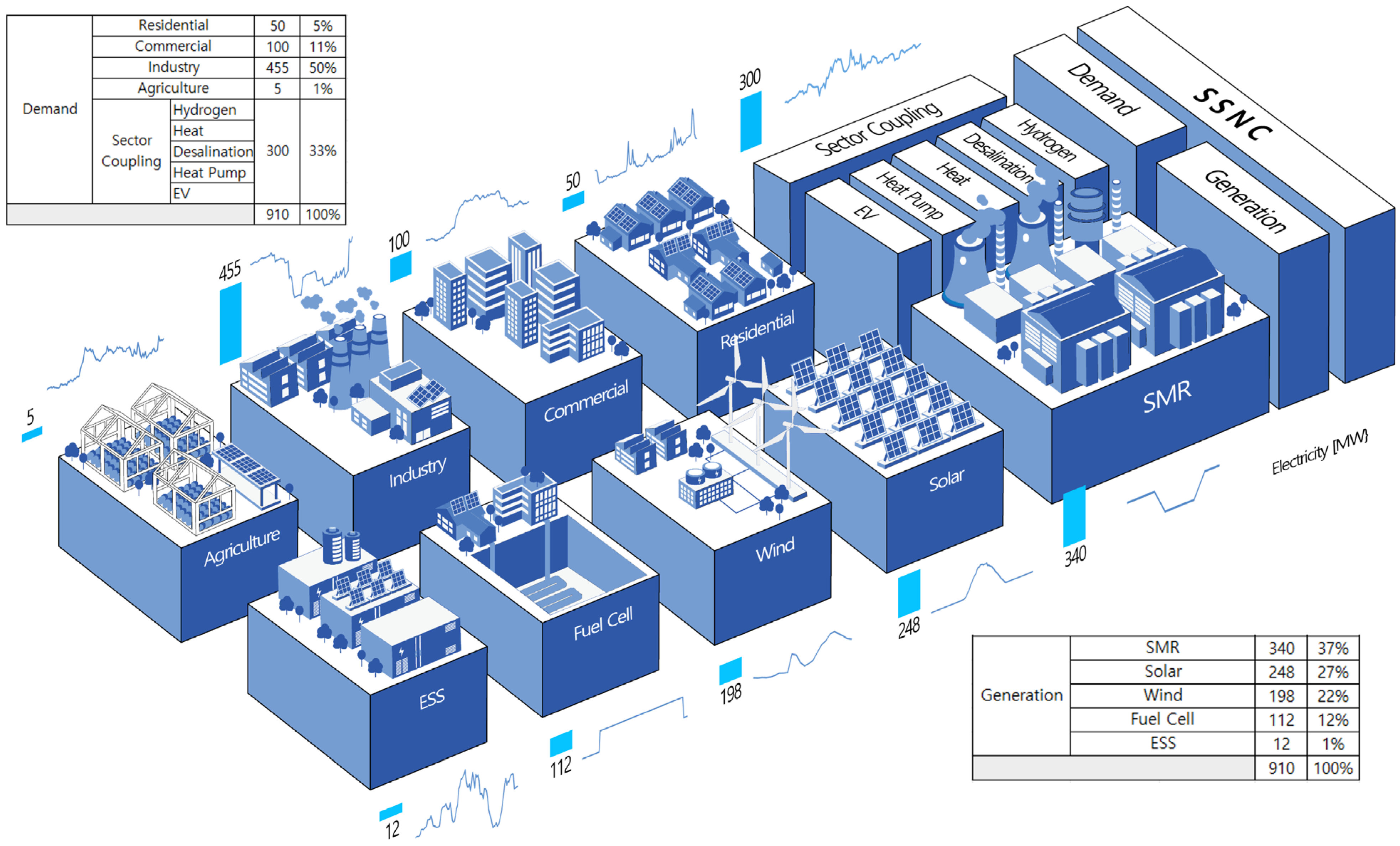
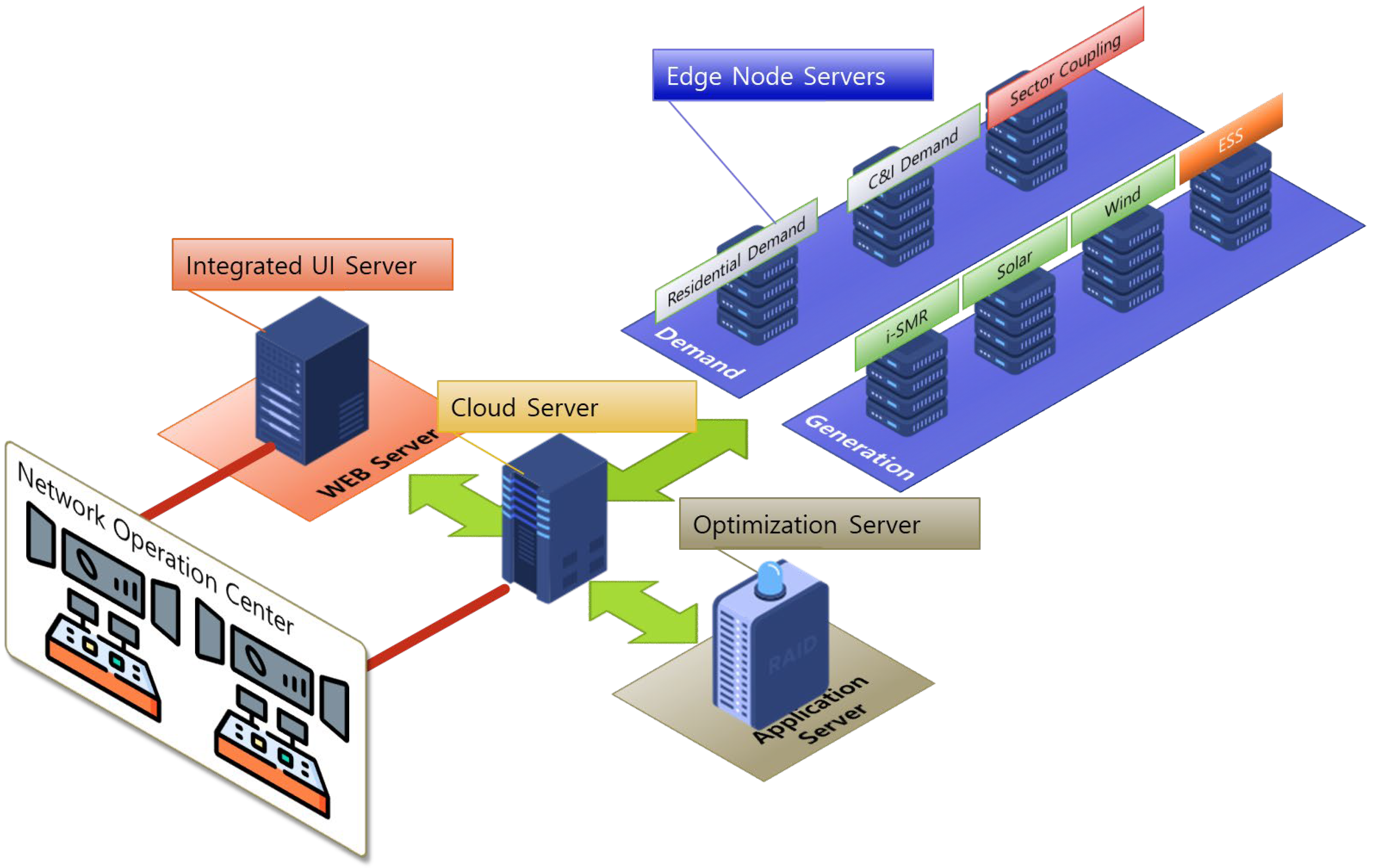
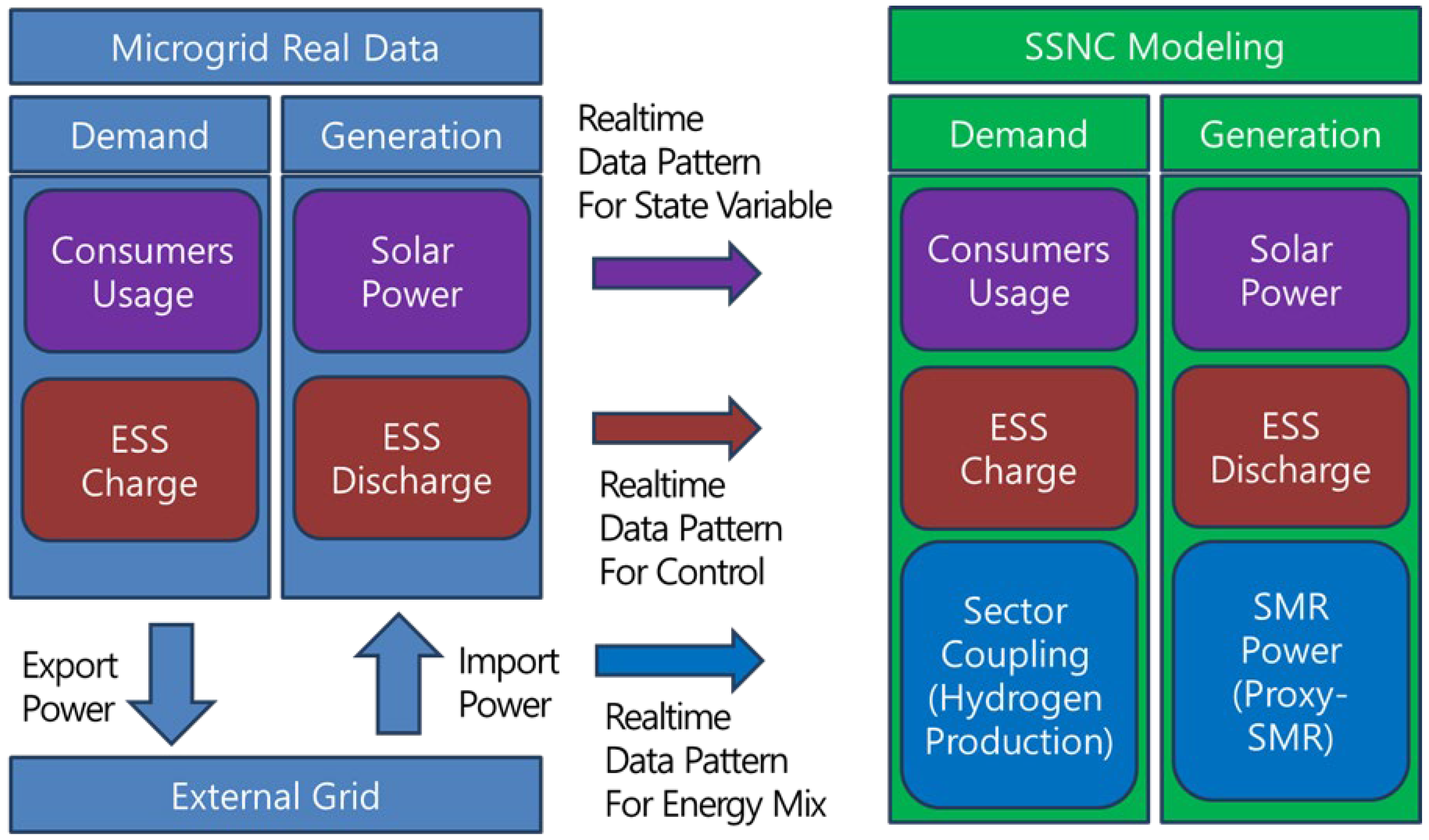
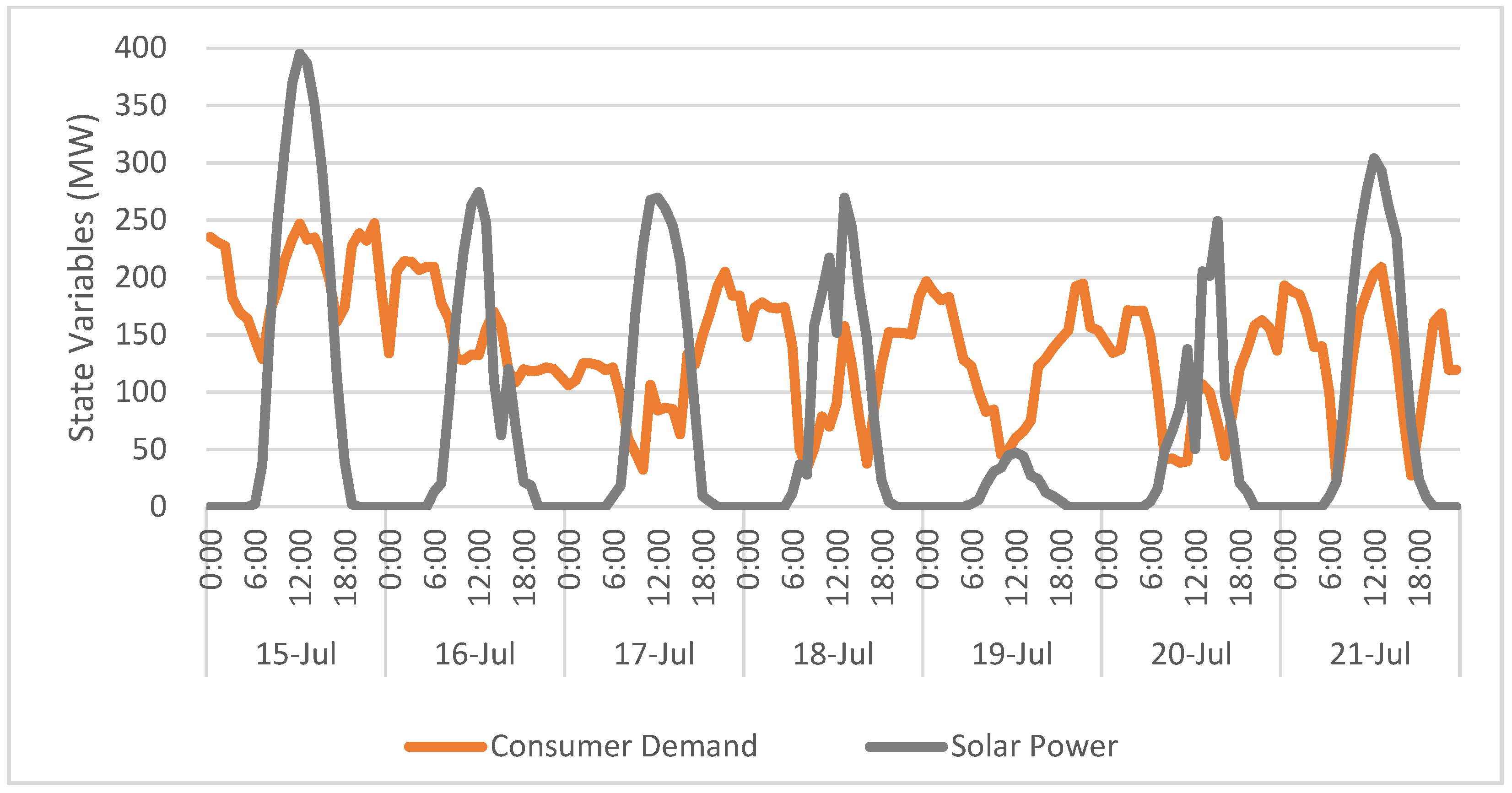
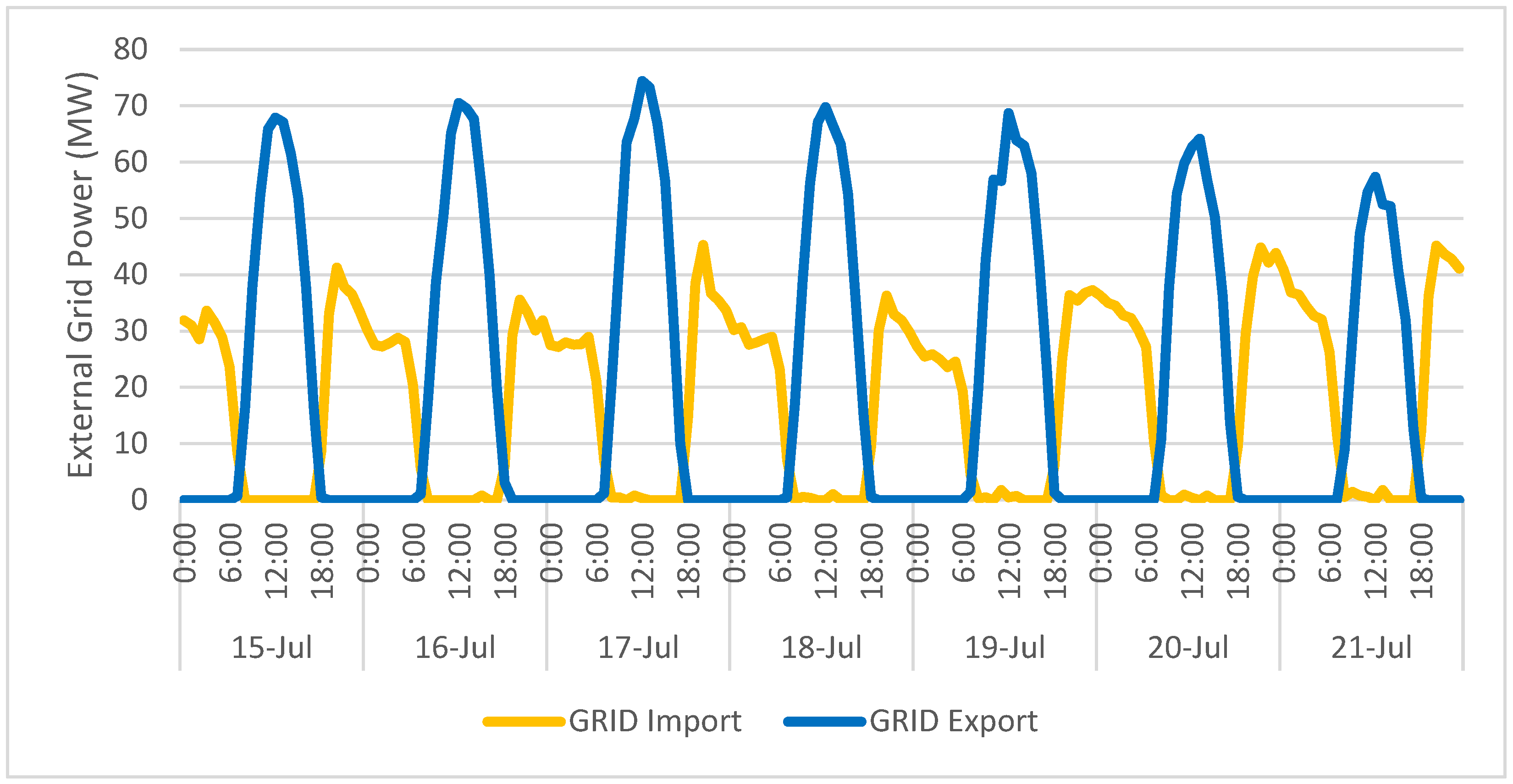
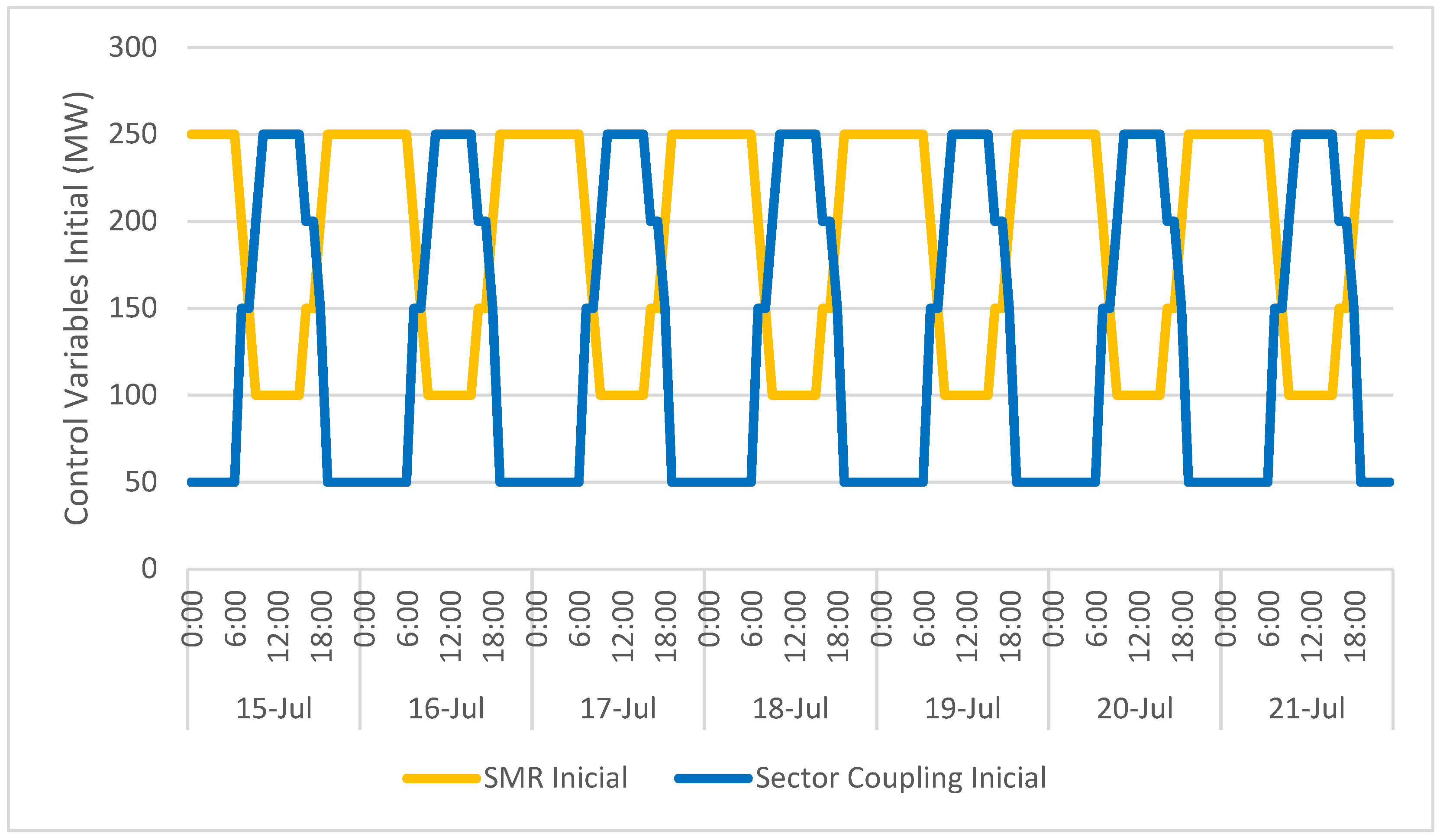
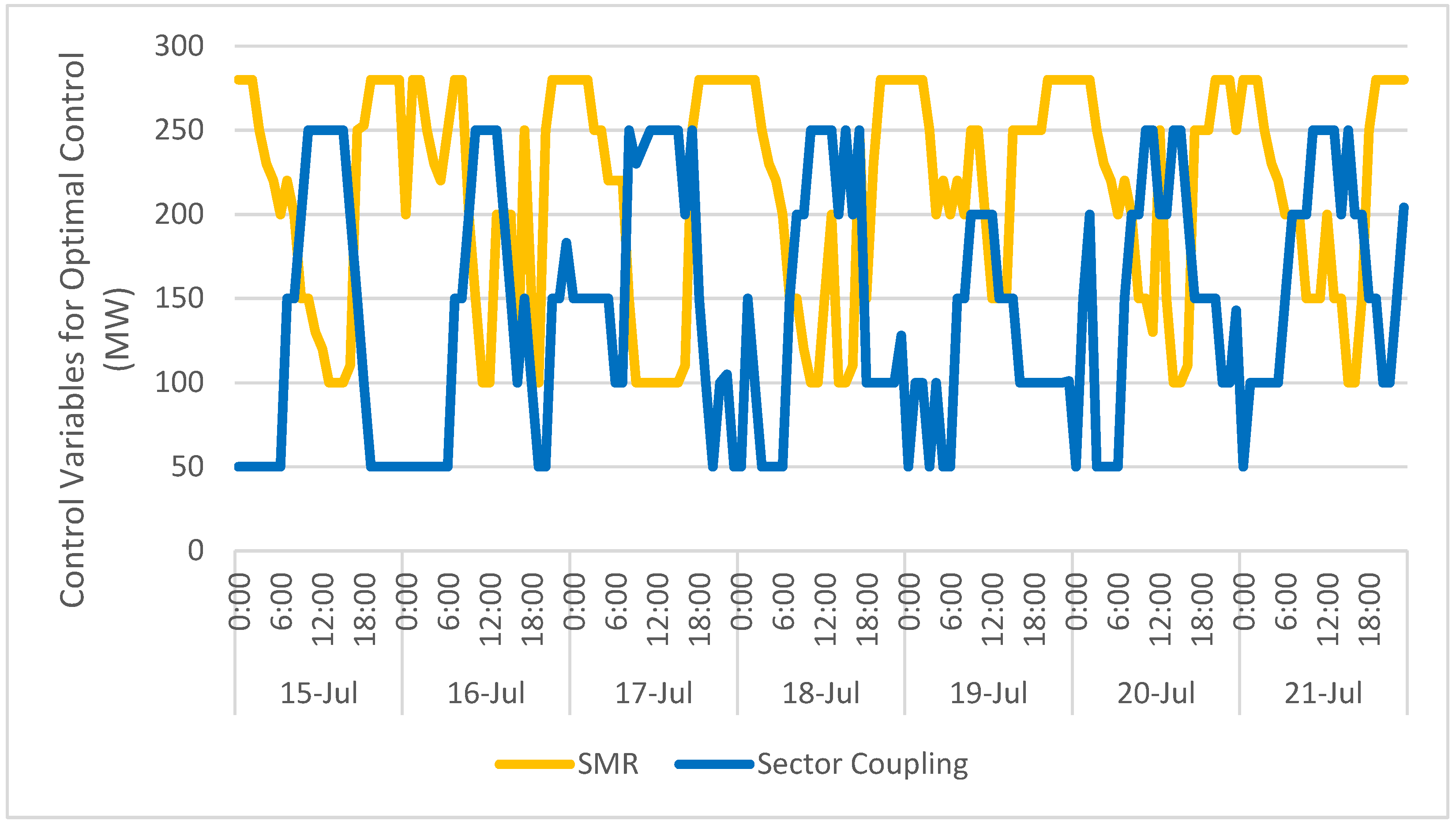
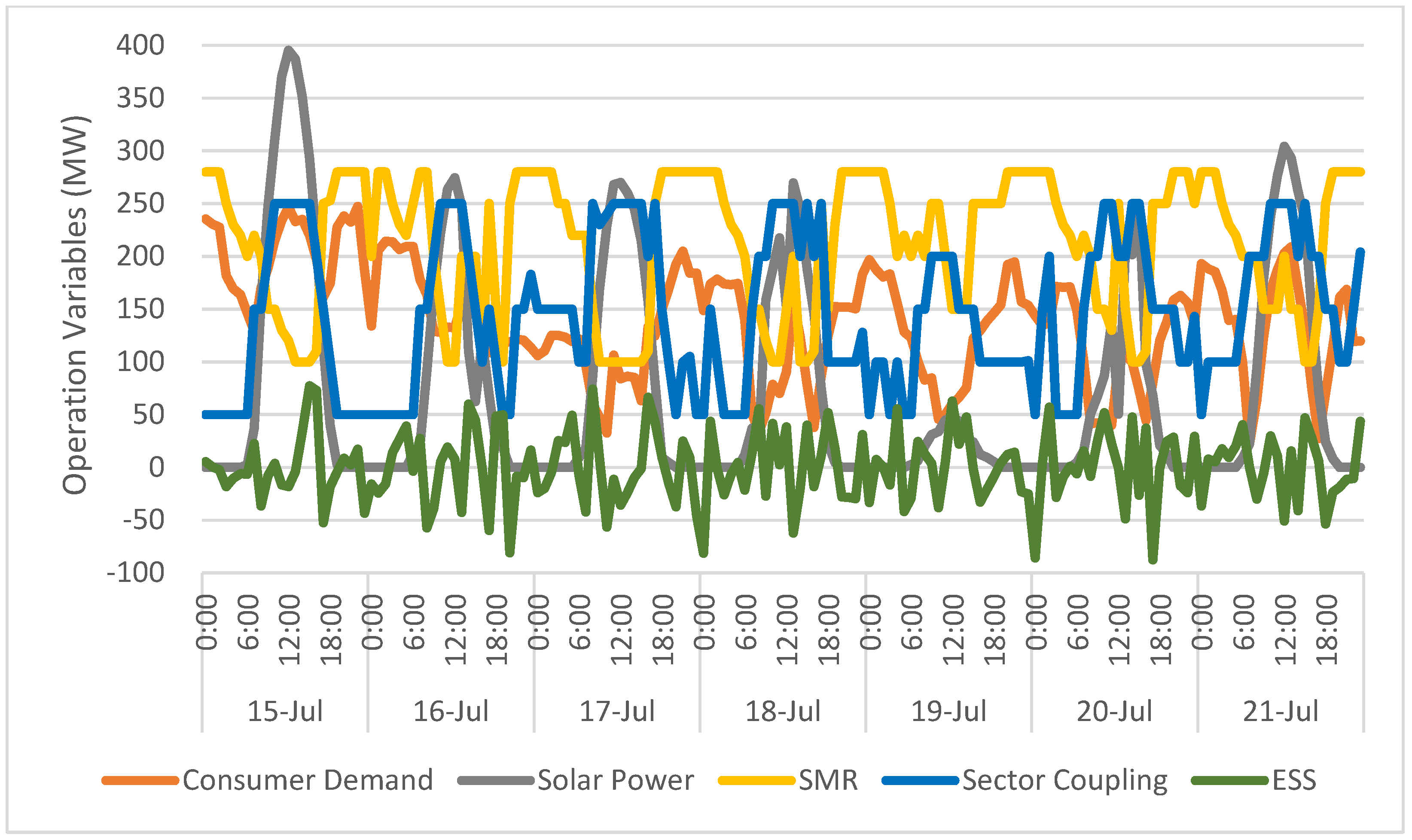
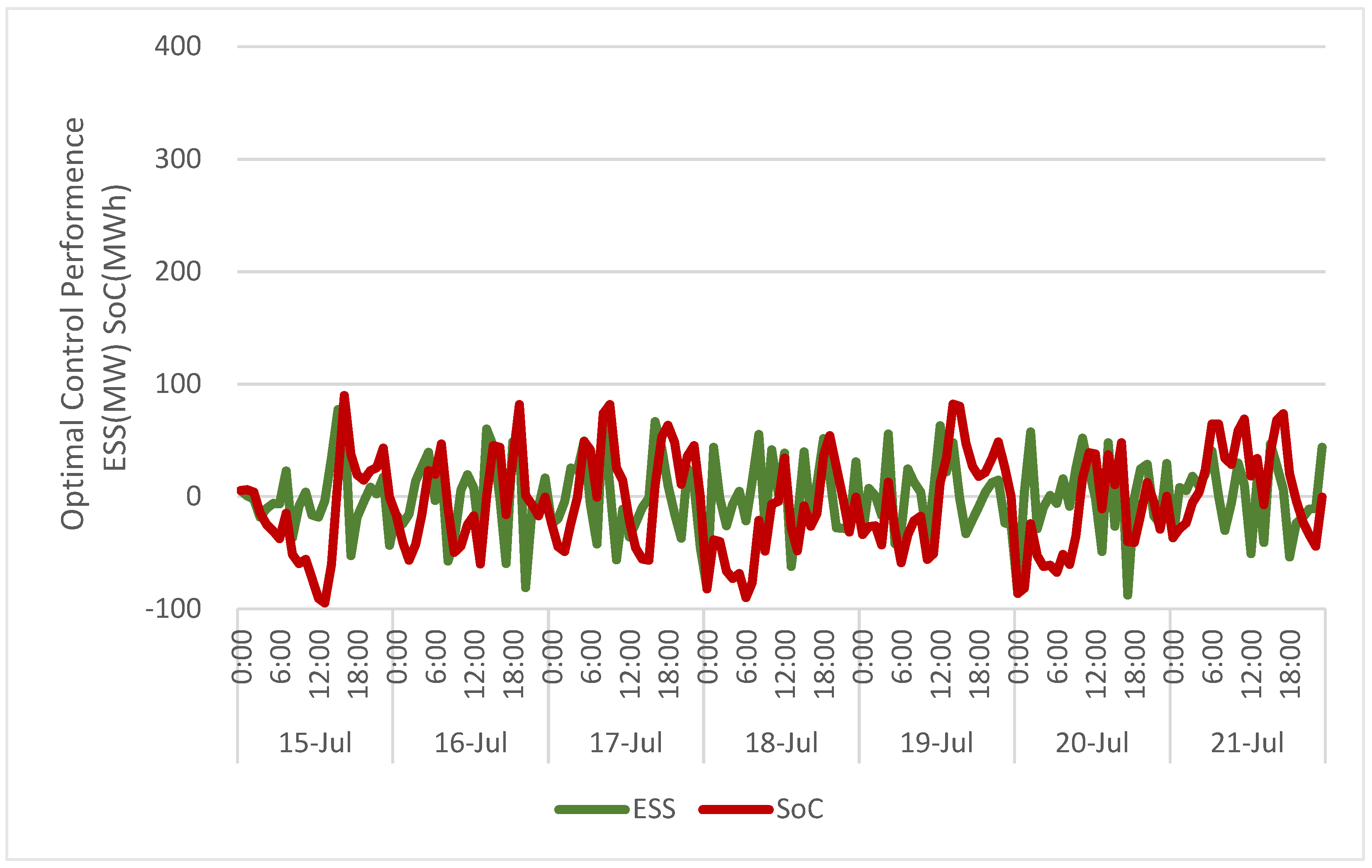
Disclaimer/Publisher’s Note: The statements, opinions and data contained in all publications are solely those of the individual author(s) and contributor(s) and not of MDPI and/or the editor(s). MDPI and/or the editor(s) disclaim responsibility for any injury to people or property resulting from any ideas, methods, instructions or products referred to in the content. |
© 2025 by the authors. Licensee MDPI, Basel, Switzerland. This article is an open access article distributed under the terms and conditions of the Creative Commons Attribution (CC BY) license (https://creativecommons.org/licenses/by/4.0/).
Share and Cite
Choi, J.; Hong, J. Design and Optimization Strategy of a Net-Zero City Based on a Small Modular Reactor and Renewable Energy. Energies 2025, 18, 4128. https://doi.org/10.3390/en18154128
Choi J, Hong J. Design and Optimization Strategy of a Net-Zero City Based on a Small Modular Reactor and Renewable Energy. Energies. 2025; 18(15):4128. https://doi.org/10.3390/en18154128
Chicago/Turabian StyleChoi, Jungin, and Junhee Hong. 2025. "Design and Optimization Strategy of a Net-Zero City Based on a Small Modular Reactor and Renewable Energy" Energies 18, no. 15: 4128. https://doi.org/10.3390/en18154128
APA StyleChoi, J., & Hong, J. (2025). Design and Optimization Strategy of a Net-Zero City Based on a Small Modular Reactor and Renewable Energy. Energies, 18(15), 4128. https://doi.org/10.3390/en18154128




